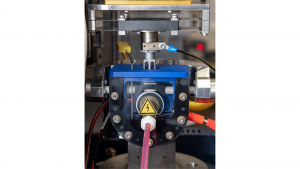A team at the Southwest Research Institute has developed a mechanical test device to examine the friction and wear associated with electric vehicle fluids.
The Southwest Research Institute team modified a commercial tribology testing device to allow it to assess the impact of electrical currents on fluids. The device can measure the wear and friction associated with electric vehicle fluids in the presence of an applied voltage.
The importance of testing electric vehicle fluids
As the transportation sector transitions into its electrified future, it is crucial that electric vehicle fluids are specifically created to match the performance requirements of electric car electrical components.
“The electrification of the automotive industry has accelerated in recent years, with future projections showing exponential growth in market share for both light and heavy-duty applications,” said Cole T Frazier, engineer at ‘research by SwRI’s Advanced Lubricants Section.
“Traditional fluid testing tools, however, were not developed to effectively analyze lubricant properties in electrified environments. This also extends to tribology testing.”
Tribology is the study of friction, lubrication and wear, and is carried out to evaluate the characteristics of vehicle fluids. The development of specific fluids for electric vehicles is essential to ensure that performance can be increased, ensuring that electric cars are efficient for the world’s clean future.
However, testing electric vehicle fluids is challenging, as the presence of an electrical potential applied to component and lubricant interfaces prevents successful evaluation.
Overcoming the challenges of the tests
To successfully test electric vehicle fluids, Dr. Carlos Sánchez, senior research engineer in SwRI’s Tribology Research and Evaluations section, designed a new test rig, built around a test machine traditional universal, to model the effects of electrification on rotating parts. Throughout the project, the team further developed the setup and test protocol.

Most electric vehicles use permanent magnet or alternating current (AC) induction motors, powered by on-board battery packs. The direct current (DC) voltage input from the batteries is converted by an inverter to the AC power required to run the vehicle’s engine.
“The many rotating surfaces inside electric vehicles are exposed to voltage spikes during the DC to AC conversion process,” said Sanchez. “Spikes and the electric field inherent in high-voltage environments can allow electrical currents to flow through surfaces, damaging the fluids and materials in electric vehicles that keep them moving smoothly.”
The speed of the frequency conversion from DC to AC can cause local voltage spikes that require grounding. Because motor bearings are located near voltage peaks, they are often susceptible to electrical currents flowing through them. The electrical potential of the bearings can be increased until the voltage breaks the thin film of the electric vehicle fluid, separating the small ball bearings from the raceways or bearing housing. This can cause surface damage and scarring.
The team created and reviewed a test protocol for the new instrument
The new protocol developed by the researchers would better represent the real system and produce relevant results. Using this breakthrough, the team tested several different commercial electric vehicle fluids and evaluated wear scars and friction on raceways and bearing housings. The team discovered that the electrical potential through a fluid, whether the current is AC or DC, can affect bearing wear and friction by up to 20%.
“SwRI specializes in building custom tribology equipment and testing capabilities to enable the industry to test multiple lubricant formulations efficiently, without requiring large-scale testing,” said Lee, who leads tribology activities at SWRI.
“In this case, since lubricant breakdown is shown to be fluid-dependent, formulators can optimize lubricants for specific electric vehicle transmissions. SwRI’s bench-scale testing capabilities will accelerate lubricant optimization, improving durability and increasing vehicle range by reducing friction.”



